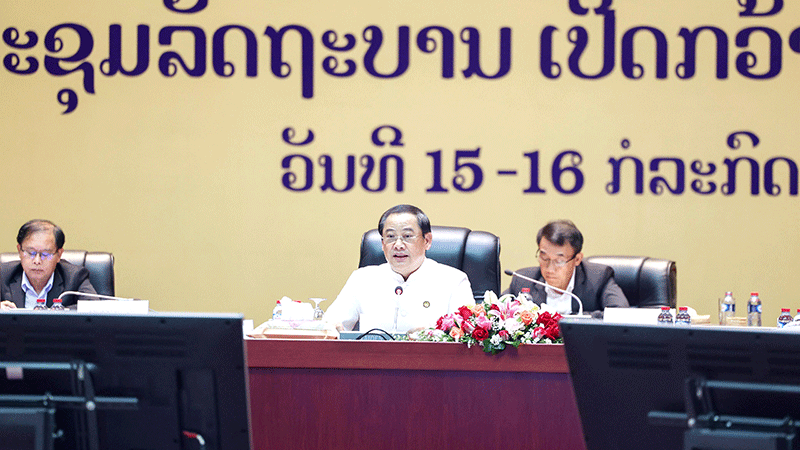 |
Prime Minister Sonexay Siphandone addresses the government meeting on Wednesday. |
Govt sets course for sustained economic growth, tackles key challenges
The government has approved key priorities and action plans to address economic challenges and drive growth, following strong performance in the first half of 2025.
Chaired by Prime Minister Sonexay Siphandone, the cabinet meeting with provincial governors and representatives from key state bodies noted that the economy grew by 4.5 percent in the first half of 2025.
This growth has been underpinned by sectors including services, agriculture, forestry, infrastructure development, and exports.
Dry-season rice production exceeded 423,800 tonnes, or 94 percent of the 2025 target, while agriculture and forestry exports exceeded US$1.12 billion, reaching 75 percent of the plan.
State revenue collection rose to 37,758 billion kip, equivalent to 55 percent of the target for 2025, while expenditure was recorded at 28,223 billion kip, equalling 39 percent of the target for this year.
The government prioritised expenditure for salary and allowance payments for civil servants, military and police personnel, retirees, people with disabilities, and volunteer teachers.
Inflation averaged 11 percent in the first half of the year and is expected to fall to single digits by year-end.
Foreign currency reserves were sufficient to cover 4.9 months of imports and are projected to cover five months of imports by December.
Progress was also made on debt repayment, price stabilisation, and food security.
The government has suspended the approval of new mining contracts, while inspections of gold and rare earth mining activities are continuing.
The meeting highlighted progress made on the construction of river bridges around the country and approved in principle a list of road construction and improvement projects for 2026 and beyond.
In parallel, the government is promoting expressway and rail development, including the Laos-China Expressway from Oudomxay to the Boten border, the Vientiane-Hanoi Expressway, and the Vientiane-Thakhaek-Vung Ang Railway.
In the area of land management, more than 76,900 land titles were issued, representing 26 percent of the target for 2025.
To address the chronic teacher shortage, the government increased the allowances paid to trainee teachers, agreed to give volunteer teachers civil servant status, and assigned military personnel to teaching duties.
In the public health sector, improvements have been made to medical infrastructure and the training of personnel at both the central and local levels.
The government aims to finalise evaluation of the 9th five-year National Socio-Economic Development Plan for 2021-2025 and the 2025 plan. At the same time, drafting of the 10th five-year plan for 2026-2030 and the 2026 plan will continue, in preparation for submission to the next sitting of the National Assembly.
In addition, the government will address challenges such as teacher and labour shortages, school dropout rates, and salaries.
Work will also continue to resolve issues related to electricity pricing, informal trade, illegal vehicle imports, and fuel price risks.
The meeting also approved in principle proposed solutions on electricity price adjustments, the impact of a 40 percent tariff increase by the United States of America on Lao exports, the management of consumer goods and fuel prices, wet season export plans, and a fund to support domestic goods production.
by Bounfaeng Phaymanivong
(Latest Update July 18, 2025)
|


